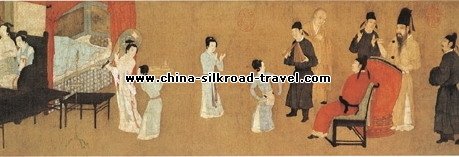Introduction of Music and Dance from Western Regions
The opening of the silk road also facilitated the exchange of music culture between the Western Region and the Central Plains.As a result western ethnic musical instruments,as well as western music and dance entered the Central Plains areas and were lived by the Han people.

 During the Wei and the Jin dynasties,social unrest triggered the migration and reintegration of many ethnic peoples. As a result a large number of music and dance from the Western Regions entered the inland areas by way of the Silk Road.Between the years 386-432,Lv Guang of Later Liang defeated Qiuci. Among the trophies there was a complete Qiuci band. Quoted from the Music Chapter of Works for Emperor(Tai Ping Tu Lan),the band had twenty musicians and fifteen types of musical instruments including vertical harp, pipa(four-stringed Chinese lute),five strings,Sheng(Chinese wind pipe),flute,panpipe, Tartar pipe,Maoyuan drum,Dutan drum Sumatra drum,waist drum,Jie drum,chicken basket drum,cymbals,conch,etc.
During the Wei and the Jin dynasties,social unrest triggered the migration and reintegration of many ethnic peoples. As a result a large number of music and dance from the Western Regions entered the inland areas by way of the Silk Road.Between the years 386-432,Lv Guang of Later Liang defeated Qiuci. Among the trophies there was a complete Qiuci band. Quoted from the Music Chapter of Works for Emperor(Tai Ping Tu Lan),the band had twenty musicians and fifteen types of musical instruments including vertical harp, pipa(four-stringed Chinese lute),five strings,Sheng(Chinese wind pipe),flute,panpipe, Tartar pipe,Maoyuan drum,Dutan drum Sumatra drum,waist drum,Jie drum,chicken basket drum,cymbals,conch,etc.
In 568 when Yu Wenyong,Emperor Wu of the Northern Zhou Dynasty married Princess Ashina,the Turkish Khan sent a Western Region orchestra composed of more than three hundred musicians from Qiuci,Shule,Kangguo and Anguo as her daughter’s dowry. Together with the orchestra,the Khan also sent Su Zhipo and Bai Zhitong,two famous Qiuci musicians as her entourage to Chang’an. This eventually produced certain impact on music of the Central Plains.
 During the Sui and Tang dynasties,national unity and economic prosperity for court music and dance to prosper. Sui Dynasty established the “nine music” system for banquets and ceremonies,which included music from Western Region such as those from Qiuci, Shule,Kangguo and Western Liang. On the basis of the Sui Dynasty system,the Tang court added the Gaochang music to the list in 642,bringing the country’s highest profile music and dance program into the well known”ten music”system with those from the Western Region comprising half of it. Among the ten music works,Qiuci Music was undoubtedly the most influential one,loved by both lords and nobles as well as the common people. In addition to music works,traditional musical instruments from the Western Region such as Pipa,harp,drum,horns and others also radiated special splendor and became important instruments in music performances since Tang Dynasty.
During the Sui and Tang dynasties,national unity and economic prosperity for court music and dance to prosper. Sui Dynasty established the “nine music” system for banquets and ceremonies,which included music from Western Region such as those from Qiuci, Shule,Kangguo and Western Liang. On the basis of the Sui Dynasty system,the Tang court added the Gaochang music to the list in 642,bringing the country’s highest profile music and dance program into the well known”ten music”system with those from the Western Region comprising half of it. Among the ten music works,Qiuci Music was undoubtedly the most influential one,loved by both lords and nobles as well as the common people. In addition to music works,traditional musical instruments from the Western Region such as Pipa,harp,drum,horns and others also radiated special splendor and became important instruments in music performances since Tang Dynasty. During the Sui and Tang Dynasties,western region dance also gained popularity in inland areas. Western region dance had many styles,the most famous being the Huteng dance,Xuxuan dance and the Zhezhi dance. Huteng dance is a male also dance characterized by flashing turns and jumps,full of masculinity. Xuxuan dance is well-known for its rapid spins. As described by Tang Dynasty poet that the dancer can “spin left and right tirelessly and thousands of rounds without stopping”. Most Huxuan dancers are female. It is said that a superb dancer can spin on a rolling ball.Because Emperor Yuanzong of the Tang Dynasty had special preference for Huxuan dance,ladies in the court all learned to spin on their feet.Even the rebel leader An Lushan who was a national minority from north and west China serving as the military and administrative official and who initiated the “Anshi Rebellion” was an expert on Huxuan dance. Zhezhi dance is a vigorous, fast-paced and dynamic dance. It started off as a solo dance,but later evolved into a pas de deux and group dance.
During the Sui and Tang Dynasties,western region dance also gained popularity in inland areas. Western region dance had many styles,the most famous being the Huteng dance,Xuxuan dance and the Zhezhi dance. Huteng dance is a male also dance characterized by flashing turns and jumps,full of masculinity. Xuxuan dance is well-known for its rapid spins. As described by Tang Dynasty poet that the dancer can “spin left and right tirelessly and thousands of rounds without stopping”. Most Huxuan dancers are female. It is said that a superb dancer can spin on a rolling ball.Because Emperor Yuanzong of the Tang Dynasty had special preference for Huxuan dance,ladies in the court all learned to spin on their feet.Even the rebel leader An Lushan who was a national minority from north and west China serving as the military and administrative official and who initiated the “Anshi Rebellion” was an expert on Huxuan dance. Zhezhi dance is a vigorous, fast-paced and dynamic dance. It started off as a solo dance,but later evolved into a pas de deux and group dance. During the Yuan Dynasty,as members of the imperial family were off springs of ethnic minorities, it was very natural for court musicians to perform musical instruments of Western Regions. Yuan music was divided into two board categories of major pieces and minor pieces. Among the minors,Dhan(also known as white tail bird) was composed by the famous western region musician Shuo Delv.
During the Yuan Dynasty,as members of the imperial family were off springs of ethnic minorities, it was very natural for court musicians to perform musical instruments of Western Regions. Yuan music was divided into two board categories of major pieces and minor pieces. Among the minors,Dhan(also known as white tail bird) was composed by the famous western region musician Shuo Delv.Silk Road Travel Guide
Our Blog
- thesilkroadchina.com is Liar
- Silk Road Tours in 2020
- Silk Road Tour for Senior Citizens
- Silk Road Train Tours
- Silk Road Private Tour
- Silk Road Travel from Australia
- Silk Road Tour from Malaysia
- The First Skating Ceremony of Hemu ...
- Southern Xinjiang Travel Experience...
- Our Tour to Xinjiang Province II



